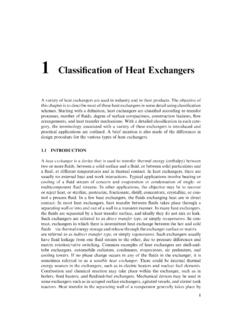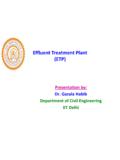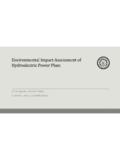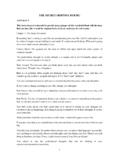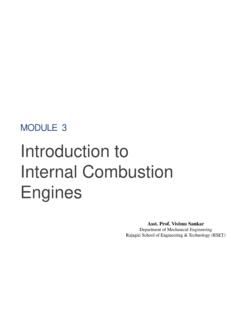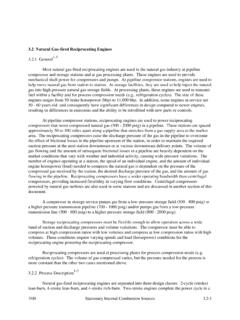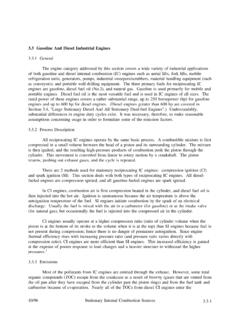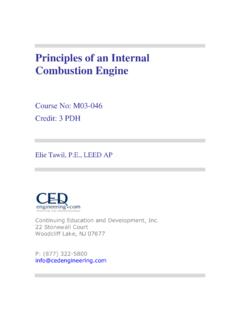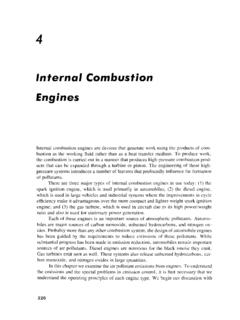Transcription of CLASSIFICATION OF INTERNAL COMBUSTION ENGINES
1 CLASSIFICATION OF INTERNAL COMBUSTION ENGINES VARIOUS TYPES OF ENGINES CLASSIFICATION OF INTERNAL COMBUSTION ENGINES 1. Application 2. Basic engine Design 3. Operating Cycle 4. Working Cycle 5. Valve/Port Design and Location 6. Fuel 7. Mixture Preparation 8. Ignition 9. Stratification of Charge 10. COMBUSTION Chamber Design 11. Method of Load Control 12. Cooling CLASSIFICATION OF INTERNAL COMBUSTION ENGINES 1. Application 1. Automotive: (i) Car (ii) Truck/Bus (iii) Off-highway 2. Locomotive 3. Light Aircraft 4. Marine: (i) Outboard (ii) Inboard (iii) Ship 5. Power Generation: (i) Portable (Domestic) (ii) Fixed (Peak Power) 6. Agricultural: (i) Tractors (ii) Pump sets 7. Earthmoving: (i) Dumpers (ii) Tippers (iii) Mining Equipment 8. Home Use: (i) Lawnmowers (ii) Snow blowers (iii) Tools 9.
2 Others The Bugatti-Veyron engine producing 1001 hp at 6000 rev/min, 8L V-16 engine Automotive Diesel engine Large Two-stroke Marine engine Another picture of the 12 cylinder engine Some facts on the 14 cylinder version: Total engine weight:2300 tons (The crankshaft alone weighs 300 tons.) Length:89 feet ( m) Height:44 feet ( m) Maximum power:108,920 hp at 102 rpm : 81,222 kW at 102 rpm Maximum torque:5,608,312 lb-ft at 102rpm CLASSIFICATION OF INTERNAL COMBUSTION ENGINES 2. Basic engine Design: 1. reciprocating (a) Single Cylinder (b) Multi-cylinder (I) In-line (ii) V (iii) Radial (iv) Opposed Cylinder (v) Opposed Piston 2.
3 Rotary: (a) Single Rotor (b) Multi-rotor Types of reciprocating ENGINES V engine RADIAL engine Wankel Rotary Piston engine Types of Rotary ENGINES Wankel engine Parts Twin-rotor Wankel Apex Seals engine Information CLASSIFICATION OF INTERNAL COMBUSTION ENGINES 3. Operating Cycle Otto (For the Conventional SI engine ) Atkinson (For Complete Expansion SI engine ) Miller (For Early or Late Inlet Valve Closing type SI engine ) Diesel (For the Ideal Diesel engine ) Dual (For the Actual Diesel engine ) CLASSIFICATION OF INTERNAL COMBUSTION ENGINES Cycle (Strokes) 1. Four Stroke Cycle:(a) Naturally Aspirated (b)Supercharged/Turbocharged 2. Two Stroke Cycle: (a) Crankcase Scavenged (b) Uniflow Scavenged (i) Inlet valve/Exhaust Port (ii) Inlet Port/Exhaust Valve (iii) Inlet and Exhaust Valve May be Naturally Aspirated Turbocharged Two stroke SI engine Two Stroke CI engine This is a type where the intake is operated through ports and exhaust through valves Two-stroke engine Inlet Port/Exhaust Valve Type Supercharging Types Difference between supercharger and turbocharger The key difference between a turbocharger and a supercharger is its power supply.
4 Something has to supply the power to run the air compressor. In a supercharger, there is a belt that connects directly to the engine . It gets its power the same way that the water pump or alternator does. A turbocharger, on the other hand, gets its power from the exhaust stream. The exhaust runs through a turbine, which in turn spins the compressor Difference between supercharger and turbocharger There are tradeoffs in both systems. In theory, a turbocharger is more efficient because it is using the "wasted" energy in the exhaust stream for its power source. On the other hand, a turbocharger causes some amount of back pressure in the exhaust system and tends to provide less boost until the engine is running at higher engine speeds. Superchargers are easier to install but tend to be more expensive. CLASSIFICATION OF INTERNAL COMBUSTION ENGINES 5. (a) Valve/Port Design 1. Poppet Valve 2. Rotary Valve 3. Reed Valve 4. Piston Controlled Porting 5.
5 (b) Valve Location 1. The T-head 2. The L-head 3. The F-head 4. The I-head: (i) Over head Valve (OHV) (ii) Over head Cam (OHC) Poppet Valve Valve Locations Valve Timing Profile CLASSIFICATION OF INTERNAL COMBUSTION ENGINES 6. Fuel : (a) Crude oil derived (i) Petrol (ii) Diesel (b) Other sources: (i) Coal (ii) Wood (includes bio-mass) (iii)Tar Sands (iv)Shale 2. Alternate: (a) Petroleum derived (i) CNG (Total Replacement) (ii) LPG (b) Bio-mass Derived (i) Ethanol (ii) Vegetable oils (iii) Producer gas (iv) Biogas (iv) Hydrogen Partial Replacement: 1. Blending 2. Dual fueling CLASSIFICATION OF INTERNAL COMBUSTION ENGINES 7. Mixture Preparation 1. Carburetion perhaps soon to be obsolete. 2. Fuel Injection (i) Diesel (ii) Gasoline (a) Manifold (b) Port (c) Cylinder BOSCH DIESEL PUMP & INJECTOR Gasoline Fuel Injection CLASSIFICATION OF INTERNAL COMBUSTION ENGINES 8.
6 Ignition 1. Spark Ignition - homogeneous charge (a) Conventional (i) Battery (ii) Magneto (b) Other methods 2. Compression Ignition - heterogeneous charge (conventional) 3. Compression ignition - homogeneous charge (hcci) CLASSIFICATION OF INTERNAL COMBUSTION ENGINES 9. Charge Stratification Charge (Also Pre-mixed charge) 2. Stratified Charge (i) With carburetion (ii) With fuel injection Charge Stratification CLASSIFICATION OF INTERNAL COMBUSTION ENGINES 10. COMBUSTION Chamber Design 1. Open Chamber: (i) Disc type (ii) Wedge (iii) Hemispherical (iv) Bowl-in-piston (v) Other design 2. Divided Chamber: (For CI): (i) Swirl chamber (ii) Pre-chamber (For SI) (i) CVCC (ii) Other designs COMBUSTION Chamber Designs COMBUSTION Chamber Design COMBUSTION Chamber Design COMBUSTION Chamber Design COMBUSTION Chamber Design COMBUSTION Chamber Design COMBUSTION Chamber Design CLASSIFICATION OF INTERNAL COMBUSTION ENGINES 11.
7 Method of Load Control 1. Throttling: (To keep mixture strength constant) Also called Charge Control Used in the Carbureted engine 2. Fuel Control (To vary the mixture strength according to load) Used in the engine 3. Combination Used in the Fuel-injected engine . CLASSIFICATION OF INTERNAL COMBUSTION ENGINES 12. Cooling Air-cooling Air-cooling (Liquid Cooling) 3. Low Heat Rejection (Semi-adiabatic) engine .


